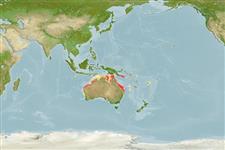Environment: milieu / climate zone / depth range / distribution range
Écologie
marin démersal. Subtropical; 10°S - 32°S
Eastern Indian Ocean: Western Australia. Western Central Pacific: Queensland, Australia.
Taille / Poids / Âge
Maturity: Lm ? range ? - ? cm
Max length : 6.4 cm TL mâle / non sexé; (Ref. 33839)
Body gibbous; greatest depth 37-40% SL; covered with highly modified scales, each with a small spinous point. Interorbital ridges thick and fused in the middle of interorbit. Dorsal margin of operculum inclined about 35° above horizontal (Ref. 39602).
Found on soft bottomed inshore areas.
Life cycle and mating behavior
Maturities | Reproduction | Spawnings | Egg(s) | Fecundities | Larves
Paxton, J.R., D.F. Hoese, G.R. Allen and J.E. Hanley, 1989. Pisces. Petromyzontidae to Carangidae. Zoological Catalogue of Australia, Vol. 7. Australian Government Publishing Service, Canberra, 665 p. (Ref. 7300)
Statut dans la liste rouge de l'IUCN (Ref. 130435)
Menace pour l'homme
Harmless
Utilisations par l'homme
Pêche sportive: oui
Outils
Articles particuliers
Télécharger en XML
Sources Internet
Estimates based on models
Preferred temperature (Ref.
123201): 24.1 - 28.5, mean 26.7 °C (based on 214 cells).
Phylogenetic diversity index (Ref.
82804): PD
50 = 0.6250 [Uniqueness, from 0.5 = low to 2.0 = high].
Bayesian length-weight: a=0.00389 (0.00180 - 0.00842), b=3.12 (2.94 - 3.30), in cm total length, based on all LWR estimates for this body shape (Ref.
93245).
Niveau trophique (Ref.
69278): 3.3 ±0.3 se; based on size and trophs of closest relatives
Fishing Vulnerability (Ref.
59153): Low vulnerability (10 of 100).
